Publikationen
Wissenschaftliche Publikationen
Vor meiner Tätigkeit als Bürgermeister war ich als Wissenschaftler an der Universität Konstanz tätig. In dieser Zeit ist meine Dissertation am Lehrstuhl für Entwicklungsneurobiologie von Frau Prof. Dr. Claudia A. O. Stürmer entstanden.
 |
Identifizierung und Charakterisierung von RTN-4/Nogo-Homologen in Amphibien und Fischen Vollständige Dissertation als PDF Download |
Die Ergebnisse, die in der Dissertation enthalten sind, wurden in wissenschaftlichen Zeitschriften als Artikel publiziert. Sie unterlagen vor Annahme zur Publikation damit dem jeweiligen Review-Systhem (einer Art Qualitätskontrolle durch anderer Wissenschaftler) der jeweiligen Zeitschrift:
 |
Oertle T, Klinger M, Stuermer CA, Schwab ME. A reticular rhapsody: phylogenic evolution and nomenclature of the RTN/Nogo gene family. FASEB J. 2003 Jul;17(10):1238-47. |
Abstract
Lesen Sie hier die englische Zusammenfassung des Publikationsinhalts:
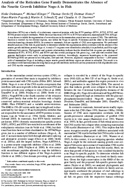 |
Diekmann H, Klinger M, Oertle T, Heinz D, Pogoda HM, Schwab ME, Stuermer CA. Analysis of the reticulon gene family demonstrates the absence of the neurite growth inhibitor Nogo-A in fish. Mol Biol Evol. 2005 Aug;22(8):1635-48. Epub 2005 Apr 27. Vollständige Pubikation auf der Seite des Journals „Molecular Biology and Evolution“ |
Abstract
Lesen Sie hier die englische Zusammenfassung des Publikationsinhalts:
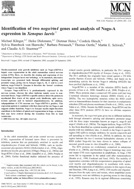 |
Klinger M, Diekmann H, Heinz D, Hirsch C, Hannbeck von Hanwehr S, Petrausch B, Oertle T, Schwab ME, Stuermer CA. Identification of two NOGO/RTN4 genes and analysis of Nogo-A expression in Xenopus laevis. Mol Cell Neurosci. 2004 Feb;25(2):205-16. Vollständige Publikation als PDF Download |
Abstract
Lesen Sie hier die englische Zusammenfassung des Publikationsinhalts:
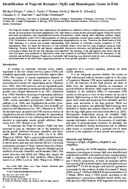 |
Klinger M, Taylor JS, Oertle T, Schwab ME, Stuermer CA, Diekmann H. Identification of Nogo-66 receptor (NgR) and homologous genes in fish. Mol Biol Evol. 2004 Jan;21(1):76-85. Epub 2003 Aug 29. Vollständige Pubikation auf der Seite des Journals „Molecular Bioligy and Evolution“ |
Abstract
Lesen Sie hier die englische Zusammenfassung des Publikationsinhalts:
Neben meiner eigenen Dissertation war ich während meiner wissenschaftlichen Arbeit noch an einer weiteren Publikation beteiligt:
 |
Haenisch C, Diekmann H, Klinger M, Gennarini G, Kuwada JY, Stuermer CA. The neuronal growth and regeneration associated Cntn1 (F3/F11/Contactin) gene is duplicated in fish: expression during development and retinal axon regeneration. Mol Cell Neurosci. 2005 Feb;28(2):361-74. Vollständige Publikation als PDF Download |
Abstract
Lesen Sie hier die englische Zusammenfassung des Publikationsinhalts:
Meine Diplomarbeit habe ich an der Universität in Freiburg angefertigt, am Lehrstuhl für Entwicklungsbiologie unter der Leitung von Prof. Dr. Wolfgang Driever.
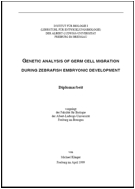 |
Genetic analysis of germ cell migration during zebrafisch embryonic development Vollständige Diplomarbeit als PDF Download |
Neben meiner eigenen Diplomarbeit war ich während dieser Zeit auch an einer wissenschaftlichen Publikation beteiligt, in die Teile meiner Diplomarbeit eingeflossen sind:
Weidinger G, Wolke U, Köprunner M, Klinger M, Raz E.
Identification of tissues and patterning events required for distinct steps in early migration of zebrafish primordial germ cells.
Development. 1999 Dec;126(23):5295-307.
Abstract
Lesen Sie hier die englische Zusammenfassung des Publikationsinhalts:
Publikationen als Sparkassen Verwaltungsrat
Als stellvertretender Vorsitzender des Verwaltungsrates der Sparkasse Engen Gottmadingen habe ich zusammen mit dem Vorstandsvorsitzenden Jürgen Stille ein Kapitel für das im Gabler Verlag erschienene „Handbuch der Regionalbanken“ zu den Anforderungen an Verwaltungsratsmitglieder für Sparkassen geschrieben.
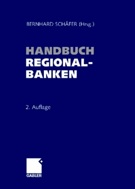 |
Klinger, Michael und Stille, Jürgen: Anforderungen an Verwaltungsratsmitglieder von Sparkassen in Handbuch der Regionalbanken. Herausgegeben von Bernhard Schäfer. 2. Auflage. Gabler Verlag, Wiesbaden 2007, Seite 649-670. Vollständiger Artikel als PDF Download |
Publikationen im Naturschutz
Gemeinsam mit Freunden habe ich einen Artikel in der Fledermausfachzeitschrift „Nyctalus“ über die Fledermauskolonie im Dach der Hebelschule in Gottmadingen veröffentlicht.
 |
Klinger M., Alder H., Fiedler W. Elektronische Quartierüberwachung einer Mausohrwochenstube (Myotis myotis). Nyctalus (N.F.). 2002; 8(2):131-40. Vollständiger Artikel als PDF Download |








































